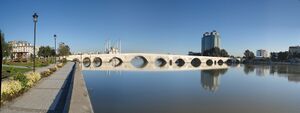Adnaniyyah
Adnaniyyah, is a province of Mansuriyyah, located in the western portion of the country.
Geography
The climate in Adnaniyyah is Mediterranean, with warm summers and mild, wet winters. The region has the highest precipitation rate in Mansuriyyah, with a yearly average rainfall above 1,000mm. Most of the terrain is comprised of plains, descending from the Matra mountains in the north to the Juwayqi Bay in the south.
A number of mountain passes connect Adnaniyyah with Ruvelka through the mountains, chief amongst them is the Dhahr al-Baydar pass, used since antiquity and stage of a famous battle during the Siduri War.
History
Adnaniyyah was part of the Makedonian Empire until its conquest by the Rawwadid sultanate in the middle ages, and therefore the region hosts Mansuriyyah’s largest collection of Makedonian monuments and historic sites.
Demographics
It’s main city and capital is Afshar, located in the Juwayqi bay at the Qarasu river mouth. Most of the population are Arabs, with a sizeable Turanian minority. An estimated 150-200 thousand ethnic Hayrenikys also live in the area, mostly in villages in the foothills south of the mountains. A few Kurdish communities are located in the east, close to the Jazirah province.
Economy
This province comprises one of Mansuriyyah’s most populous and developed regions. The combination of mild climate, fertile soil and abundant water in the form of rivers and streams flowing from the Matra mountains in the north to the Juwayqi bay to the south made the area an agricultural hotspot since antiquity, attracting different peoples to the region. The region developed quickly during Mansuri industrialization in the 19th century, benefiting from the surplus workforce, resources extracted from the foothills of the Matra Mountains, and access to ports and land routes to export its production.
The region competes with Shirvan for the title of most industrialized province in Mansuriyyah, hosting a great variety of light and heavy industries, including large steel and metal industries, as well as automotive, food processing and consumer products industries.
The mountain foothills in the north are rich with mineral resources such as zinc, chrome, iron and limestone.
Adnaniyyah produces several types of fruits, sugar cane, soybean and vegetable oils. Cattle is raised in the northern mountain valleys mostly for dairy production, and aquaculture is practiced along the waters of the Juwayqi bay.



